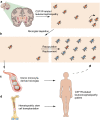Microglial replacement therapy: a potential therapeutic strategy for incurable CSF1R-related leukoencephalopathy
- PMID: 33287883
- PMCID: PMC7720517
- DOI: 10.1186/s40478-020-01093-3
Microglial replacement therapy: a potential therapeutic strategy for incurable CSF1R-related leukoencephalopathy
Abstract
CSF1R-related leukoencephalopathy is an adult-onset leukoencephalopathy with axonal spheroids and pigmented glia caused by colony stimulating factor 1 receptor (CSF1R) gene mutations. The disease has a global distribution and currently has no cure. Individuals with CSF1R-related leukoencephalopathy variably present clinical symptoms including cognitive impairment, progressive neuropsychiatric and motor symptoms. CSF1R is predominantly expressed on microglia within the central nervous system (CNS), and thus CSF1R-related leukoencephalopathy is now classified as a CNS primary microgliopathy. This urgent unmet medical need could potentially be addressed by using microglia-based immunotherapies. With the rapid recent progress in the experimental microglial research field, the replacement of an empty microglial niche following microglial depletion through either conditional genetic approaches or pharmacological therapies (CSF1R inhibitors) is being studied. Furthermore, hematopoietic stem cell transplantation offers an emerging means of exchanging dysfunctional microglia with the aim of reducing brain lesions, relieving clinical symptoms and prolonging the life of patients with CSF1R-related leukoencephalopathy. This review article introduces recent advances in microglial biology and CSF1R-related leukoencephalopathy. Potential therapeutic strategies by replacing microglia in order to improve the quality of life of CSF1R-related leukoencephalopathy patients will be presented.
Keywords: CSF1R-related leukoencephalopathy; Microglia; Microglial replacement.
Conflict of interest statement
ZKW serves as PI or Co-PI on Biogen, Inc. (228PD201), Biohaven Pharmaceuticals, Inc. (BHV4157-206 and BHV3241-301), and Neuraly, Inc. (NLY01-PD-1) grants. He serves as Co-PI of the Mayo Clinic APDA Center for Advanced Research.
Figures


References
-
- Adams SJ, Kirk A, Auer RN. Adult-onset leukoencephalopathy with axonal spheroids and pigmented glia (ALSP): integrating the literature on hereditary diffuse leukoencephalopathy with spheroids (HDLS) and pigmentary orthochromatic leukodystrophy (POLD) J Clin Neurosci. 2018;48:42–49. doi: 10.1016/j.jocn.2017.10.060. - DOI - PubMed
-
- Axelsson R, Roytta M, Sourander P, Akesson HO, Andersen O. Hereditary diffuse leucoencephalopathy with spheroids. Acta Psychiatr Scand Suppl. 1984;314:1–65. - PubMed
Publication types
MeSH terms
Substances
LinkOut - more resources
Full Text Sources
Other Literature Sources
Research Materials
Miscellaneous

